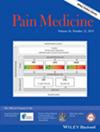Association between pro-inflammatory diet and abdominal pain: Cross-sectional and case-control study from UK biobank and NHANES 2017-2020.
IF 2.9
3区 医学
Q1 ANESTHESIOLOGY
引用次数: 0
Abstract
BACKGROUND There is a close association between diet and abdominal pain, however, relationship between inflammatory diet and characteristics of abdominal pain has not been characterized yet. METHODS This study analyzed baseline data from the UK Biobank, 3-item DHQ-Abdominal Pain Questionnaire (DHQ-3Q) which including abdominal pain in the past three months, severity of abdominal pain, and frequency of abdominal pain, and data from the National Health and Nutrition Examination Survey (NHANES) from 2017 to 2020. Energy-adjusted Dietary Inflammatory Index (E-DII), constructed based on 26 or 27 nutrients, was analyzed using continuous or categorical methods. Logistic regression and restricted cubic spline analyses examined the association between E-DII and abdominal pain. RESULTS In UK Biobank, compared to participants in the lowest quintile of E-DII, the adjusted ORs for the highest quintile were 1.12 (95% CI 1.02-1.24; p = 0.022), 1.05 (95% CI 1.00-1.09; p = 0.030), 1.26 (95% CI 1.17-1.36; p < 0.001), and 1.10 (95% CI 1.00-1.20; p = 0.044) for chronic abdominal pain, abdominal pain in the past three months, severity of abdominal pain, and frequency of abdominal pain, respectively. In NHANES, compared to participants in the lowest quintile of E-DII, the adjusted ORs for the highest quintile were 1.46 (95% CI 1.20-1.77; p < 0.001), 1.75 (95% CI 1.20-2.60; p = 0.005), 1.45 (95% CI 1.14-1.87; p = 0.003), and 1.18 (95% CI 0.82-1.72; p = 0.380) for abdominal pain in the past year, upper left abdominal pain, upper middle abdominal pain, and upper right abdominal pain. Additionally, there was a nonlinear correlation between E-DII score and DHQ-3Q (p nonlinear <0.001). CONCLUSION Following a pro-inflammatory diet is linked to a higher likelihood of experiencing abdominal pain, as well as increased severity and frequency of such pain. Therefore, further longitudinal studies are necessary to investigate this relationship.促炎性饮食与腹痛之间的关系:来自英国生物库和 NHANES 2017-2020 的横断面和病例对照研究。
背景这项研究分析了英国生物库的基线数据、3项DHQ-腹痛问卷(DHQ-3Q)(包括过去3个月的腹痛、腹痛严重程度和腹痛频率)以及2017年至2020年美国国家健康与营养调查(NHANES)的数据。根据26或27种营养素构建的能量调整膳食炎症指数(E-DII)采用连续或分类方法进行分析。结果在英国生物库中,与 E-DII 最低五分位数的参与者相比,最高五分位数的调整 OR 为 1.12(95% CI 1.02-1.24;P = 0.022)、1.05(95% CI 1.00-1.09;p = 0.030)、1.26(95% CI 1.17-1.36;p < 0.001)和 1.10(95% CI 1.00-1.20;p = 0.044),分别为慢性腹痛、过去三个月腹痛、腹痛严重程度和腹痛频率。在 NHANES 中,与 E-DII 最低五分位数的参与者相比,最高五分位数的调整 OR 分别为 1.46 (95% CI 1.20-1.77; p < 0.001)、1.75 (95% CI 1.20-2.60; p = 0.005)、1.45 (95% CI 1.14-1.87; p = 0.003),过去一年腹痛、左上腹痛、中上腹痛和右上腹痛的相关系数分别为 1.18 (95% CI 0.82-1.72; p = 0.380)。此外,E-DII 评分与 DHQ-3Q 之间存在非线性相关性(p 非线性 <0.001)。因此,有必要开展进一步的纵向研究来探讨这种关系。
本文章由计算机程序翻译,如有差异,请以英文原文为准。
求助全文
约1分钟内获得全文
求助全文
来源期刊

Pain Medicine
医学-医学:内科
CiteScore
6.50
自引率
3.20%
发文量
187
审稿时长
3 months
期刊介绍:
Pain Medicine is a multi-disciplinary journal dedicated to pain clinicians, educators and researchers with an interest in pain from various medical specialties such as pain medicine, anaesthesiology, family practice, internal medicine, neurology, neurological surgery, orthopaedic spine surgery, psychiatry, and rehabilitation medicine as well as related health disciplines such as psychology, neuroscience, nursing, nurse practitioner, physical therapy, and integrative health.
 求助内容:
求助内容: 应助结果提醒方式:
应助结果提醒方式:


